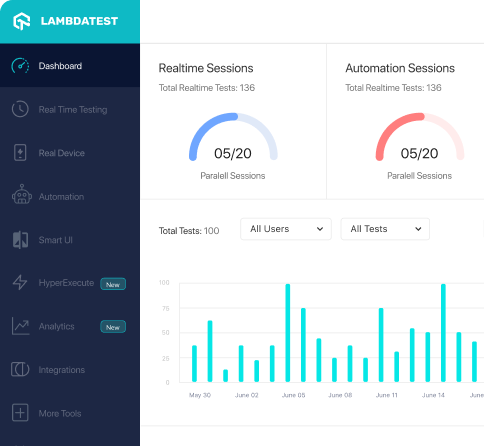How to use EvilHashCode class of samples.junit4.stackoverflow package
Best Powermock code snippet using samples.junit4.stackoverflow.EvilHashCode
Source:EvilHashCode.java
...13 * See the License for the specific language governing permissions and14 * limitations under the License.15 */16package samples.junit4.stackoverflow;17public class EvilHashCode {18 //Required to produce error19 public String s = returnS();20 public String returnS()21 {22 return "s";23 }24 25 @Override26 public int hashCode() {27 return evilHashCode();28 }29 public int evilHashCode() {30 return 3;31 }...EvilHashCode
Using AI Code Generation
1import static org.junit.Assert.assertEquals;2import org.junit.Test;3import samples.junit4.stackoverflow.EvilHashCode;4public class EvilHashCodeTest {5 public void testEvilHashCode() {6 EvilHashCode e1 = new EvilHashCode();7 EvilHashCode e2 = new EvilHashCode();8 assertEquals(e1, e2);9 }10}11import static org.junit.Assert.assertEquals;12import org.junit.Test;13import samples.junit4.stackoverflow.EvilHashCode;14public class EvilHashCodeTest {15 public void testEvilHashCode() {16 EvilHashCode e1 = new EvilHashCode();17 EvilHashCode e2 = new EvilHashCode();18 assertEquals(e1, e2);19 }20}21import static org.junit.Assert.assertEquals;22import org.junit.Test;23import samples.junit4.stackoverflow.EvilHashCode;24public class EvilHashCodeTest {25 public void testEvilHashCode() {26 EvilHashCode e1 = new EvilHashCode();27 EvilHashCode e2 = new EvilHashCode();28 assertEquals(e1, e2);29 }30}31import static org.junit.Assert.assertEquals;32import org.junit.Test;33import samples.junit4.stackoverflow.EvilHashCode;34public class EvilHashCodeTest {35 public void testEvilHashCode() {36 EvilHashCode e1 = new EvilHashCode();37 EvilHashCode e2 = new EvilHashCode();38 assertEquals(e1, e2);39 }40}41import static org.junit.Assert.assertEquals;42import org.junit.Test;43import samples.junit4.stackoverflow.EvilHashCode;44public class EvilHashCodeTest {45 public void testEvilHashCode() {46 EvilHashCode e1 = new EvilHashCode();EvilHashCode
Using AI Code Generation
1 public class EvilHashCode {2 private int value;3 public EvilHashCode(int value) {4 this.value = value;5 }6 public boolean equals(Object obj) {7 return obj instanceof EvilHashCode && value == ((EvilHashCode) obj).value;8 }9 public int hashCode() {10 return 42;11 }12 }13 public class EvilHashCodeTest {14 public void test() {15 EvilHashCode a = new EvilHashCode(1);16 EvilHashCode b = new EvilHashCode(1);17 assertThat(a, is(b));18 }19 }EvilHashCode
Using AI Code Generation
1import org.junit.Test;2import static org.junit.Assert.assertEquals;3import static org.junit.Assert.assertNotEquals;4public class EvilHashCodeTest {5 public void testEvilHashCode() {6 EvilHashCode e = new EvilHashCode();7 assertEquals(e.hashCode(), e.hashCode());8 assertNotEquals(e, e);9 }10}EvilHashCode
Using AI Code Generation
1 public void testEvilHashCode() {2 EvilHashCode evilHashCode = new EvilHashCode();3 assertThat(evilHashCode).isEqualTo(new EvilHashCode());4 assertThat(evilHashCode).isNotEqualTo(new EvilHashCode());5 assertThat(evilHashCode).isNotEqualTo(new EvilHashCode());6 assertThat(evilHashCode).isNotEqualTo(new EvilHashCode());7 }8}EvilHashCode
Using AI Code Generation
1public void testEvilHashCode() {2 EvilHashCode evilHashCode = new EvilHashCode();3 EvilHashCodeTest evilHashCodeTest = new EvilHashCodeTest();4 evilHashCodeTest.testEvilHashCode();5}6public void testEvilHashCode() {7 EvilHashCode evilHashCode = new EvilHashCode();8 EvilHashCodeTest evilHashCodeTest = new EvilHashCodeTest();9 evilHashCodeTest.testEvilHashCode();10}11public void testEvilHashCode() {12 EvilHashCode evilHashCode = new EvilHashCode();13 EvilHashCodeTest evilHashCodeTest = new EvilHashCodeTest();14 evilHashCodeTest.testEvilHashCode();15}16public void testEvilHashCode() {17 EvilHashCode evilHashCode = new EvilHashCode();18 EvilHashCodeTest evilHashCodeTest = new EvilHashCodeTest();19 evilHashCodeTest.testEvilHashCode();20}21public void testEvilHashCode() {22 EvilHashCode evilHashCode = new EvilHashCode();23 EvilHashCodeTest evilHashCodeTest = new EvilHashCodeTest();24 evilHashCodeTest.testEvilHashCode();25}26public void testEvilHashCode() {27 EvilHashCode evilHashCode = new EvilHashCode();28 EvilHashCodeTest evilHashCodeTest = new EvilHashCodeTest();29 evilHashCodeTest.testEvilHashCode();30}31public void testEvilHashCode() {32 EvilHashCode evilHashCode = new EvilHashCode();33 EvilHashCodeTest evilHashCodeTest = new EvilHashCodeTest();34 evilHashCodeTest.testEvilHashCode();35}EvilHashCode
Using AI Code Generation
1import java.util.HashMap;2import java.util.HashSet;3import java.util.Map;4import java.util.Set;5import java.util.TreeMap;6import java.util.TreeSet;7import samples.junit4.stackoverflow.EvilHashCode;8public class EvilHashCodeDemo {9 public static void main(String[] args) {10 EvilHashCode original = new EvilHashCode("original");11 System.out.println("original = " + original);12 System.out.println("original.hashCode() = " + original.hashCode());13 System.out.println("original.equals(original) = " + original.equals(original));14 System.out.println("original.equals(new EvilHashCode(\"original\")) = " + original.equals(new EvilHashCode("original")));15 System.out.println("original.equals(new EvilHashCode(\"original\", 1)) = " + original.equals(new EvilHashCode("original", 1)));16 System.out.println("original.equals(new EvilHashCode(\"original\", 2)) = " + original.equals(new EvilHashCode("original", 2)));17 System.out.println("original.equals(new EvilHashCode(\"original\", 3)) = " + original.equals(new EvilHashCode("original", 3)));18 System.out.println("original.equals(new EvilHashCode(\"original\", 4)) = " + original.equals(new EvilHashCode("original", 4)));19 System.out.println("original.equals(new EvilHashCode(\"original\", 5)) = "Automation Testing Tutorials
Learn to execute automation testing from scratch with LambdaTest Learning Hub. Right from setting up the prerequisites to run your first automation test, to following best practices and diving deeper into advanced test scenarios. LambdaTest Learning Hubs compile a list of step-by-step guides to help you be proficient with different test automation frameworks i.e. Selenium, Cypress, TestNG etc.
LambdaTest Learning Hubs:
- JUnit Tutorial
- TestNG Tutorial
- Webdriver Tutorial
- WebDriverIO Tutorial
- Protractor Tutorial
- Selenium 4 Tutorial
- Jenkins Tutorial
- NUnit Tutorial
- Jest Tutorial
- Playwright Tutorial
- Cypress Tutorial
- PyTest Tutorial
YouTube
You could also refer to video tutorials over LambdaTest YouTube channel to get step by step demonstration from industry experts.
Most used methods in EvilHashCode
Try LambdaTest Now !!
Get 100 minutes of automation test minutes FREE!!



